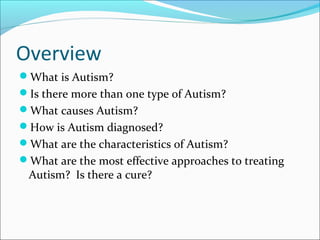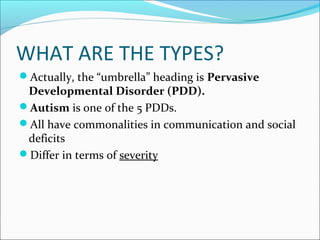What is autism ?
- 1. Overview ïWhat is Autism? ïIs there more than one type of Autism? ïWhat causes Autism? ïHow is Autism diagnosed? ïWhat are the characteristics of Autism? ïWhat are the most effective approaches to treating Autism? Is there a cure?
- 2. WHAT IS AUTISM? ïVery complex, often baffling developmental disability ïFirst described by Leo Kanner in 1943 as early infantile autism ïâAutoâ â children are âlocked within themselves.â ïFor next 30 years, considered to be an emotional disturbance
- 3. WHAT IS AUTISM? ï3 categories for autism in IDEA? ïToday, autism is a severe form of a broader group of disorders ïThese are referred to as pervasive developmental disorders (later) ïTypically appears during the first 3 years of life
- 4. WHAT IS AUTISM? ïVery likely neurological in origin â not emotional, not the refrigerator mom ïPrevalence figures vary widely (textbook says 5/10,000, but recent data say as high as 1/1000 or even 1/500. ï4 times more prevalent in boys ïNo known racial, ethnic, or social boundaries ïNo relation to family income, lifestyle
- 5. WHAT IS AUTISM? ïAutism impacts normal development of the brain in areas of social interaction and communication skills. ïDifficult to communicate with others and relate to the outside world. ïOccasionally, aggressive and/or self-injurious behavior may be present.
- 6. WHAT ARE THE TYPES? ïActually, the âumbrellaâ heading is Pervasive Developmental Disorder (PDD). ïAutism is one of the 5 PDDs. ïAll have commonalities in communication and social deficits ïDiffer in terms of severity
- 7. 1. Autistic Disorder ïImpairments in social interaction, communication, and imaginative play. ïApparent before age 3. ïAlso includes stereotyped behaviors, interests, and activities
- 8. 2. Aspergerâs Disorder ïImpairments in social interactions, and presence of restricted interests and activities ïNo clinically significant general delay in language ïAverage to above average intelligence
- 9. 3. Pervasive Developmental Disorder â Not Otherwise Specified (PDD-NOS) ïOften referred to as atypical autism ïUsed when a child does not meet the criteria for a specific diagnosis, but there is severe and pervasive impairment in specified behaviors
- 10. 4. Rettâs Disorder ïProgressive disorder which, to date, has only occurred in girls. ïPeriod of normal development and then the loss of previously acquired skills ïAlso loss of purposeful use of hands, which is replaced by repetitive hand movements ïBeginning at age of 1-4 years
- 11. 5. Childhood Disintegrative Disorder ïNormal development for at least the first 2 years ïThen significant loss of previously acquired skills
- 12. Conclusions on Types ïAutism is a spectrum disorder ïThis means that symptoms and characteristics can present themselves in wide variety of combinations, from mild to severe ïAutistic individuals can be very different from each other ïâAutismâ is still commonly used to refer to any of the 5 PDDs
- 13. What causes (and doesnât cause) autism? ïGood agreement in general that autism is caused by abnormalities in brain development, neurochemistry, and genetic factors ïBettleheimâs theory of psychogenesis?
- 14. How is Autism Diagnosed? ïNo definitive medical test ïTeam uses interviews, observation, and specific checklists developed for this purpose. ïTeam might include neurologist, psychologist, developmental pediatrician, speech/language therapist, learning consultant, etc. ïMust rule out MR, hearing impairment, behavior disorders, or eccentric habits
- 15. CHARACTERISTICS ï1. Communication/Language ï2. Social Interaction ï3. Behaviors ï4. Sensory and movement disorders ï5. Resistance to change (predictability) ï6. Intellectual functioning
- 16. 1. Communication/language ïBroad range of abilities, from no verbal communication to quite complex skills ïTwo common impairments: ïA. Delayed language ïB. Echolalia
- 17. A. Delayed language ï50% of autistic individuals will eventually have useful speech (?) ïPronoun reversal: âYou want white icing on chocolate cake.â ïDifficulty in conversing easily with others ïDifficulty in shifting topics ïLook away; poor eye contact ïFacilitated communication??????
- 18. Elements of Facilitated Communication ï1. Physical Support ï2. Initial training/introduction ï3. Maintaining focus ï4. Avoiding competence testing ï5. Generalization ï6. Fading
- 19. B. Echolalia ïCommon in very young children (Age 3) ïImmediate or delayed (even years) ïIs there communicative intent with echolalia?
- 20. 2. Social Interaction ïOne of hallmarks of autism is lack of social interaction ï1. Impaired use of nonverbal behavior ï2. Lack of peer relationships ï3. Failure to spontaneously share enjoyment, interests, etc. with others ï4. Lack of reciprocity ïTheory of mind?
- 21. 3. Behaviors ïRepetitive behaviors, including obsessions, tics, and perseveration ïImpeding behaviors (impede their learning or the learning of others) ïWill need positive behavior supports ïA. Self-injurious behavior ïB. Aggression
- 22. 4. Sensory and movement disorders ïVery common ïOver- or under-sensitive to sensory stimuli ïAbnormal posture and movements of the face, head, trunk, and limbs ïAbnormal eye movements ïRepeated gestures and mannerisms ïMovement disorders can be detected very early â perhaps at birth
- 23. 5. Predictability ïChange in routine is very stressful ïMay insist on particular furniture arrangement, food at meals, TV shows ïSymmetry is often important ïInterventions need to focus on preparing students for change if possible
- 24. 6. Intellectual functioning ïAutism occurs in children of all levels of intelligence, from those who are gifted to those who have mental retardation ïIn general, majority of individuals with autism are also identified as having mental retardation â 75% below 70 ïVerbal and reasoning skills are difficult ïSavant syndrome
- 25. Interventions ï1. Individualization and early intervention are the keys ï2. Include life skills, functional academics, and vocational preparation ï3. Positive behavior support ï4. Social stories (music therapy?) ï5. Lovaas model
- 26. Thank you Contact Us : ïhttp://cerebrabraintech.com/ ïinfo@cerebrabraintech.com ïhttps://www.facebook.com/cerebraturbobrain


























